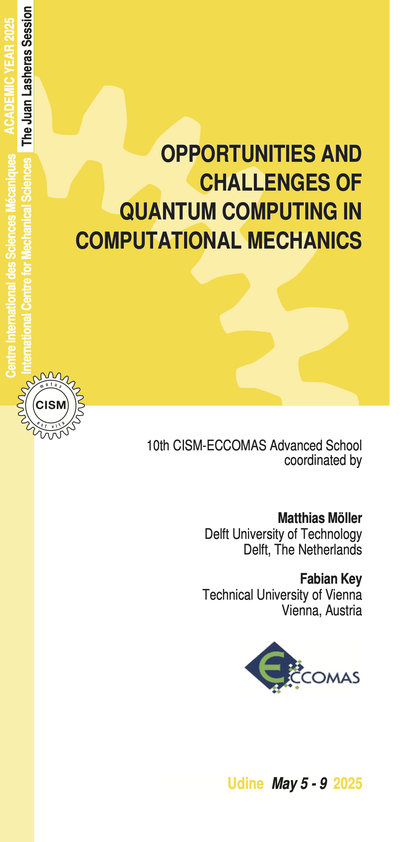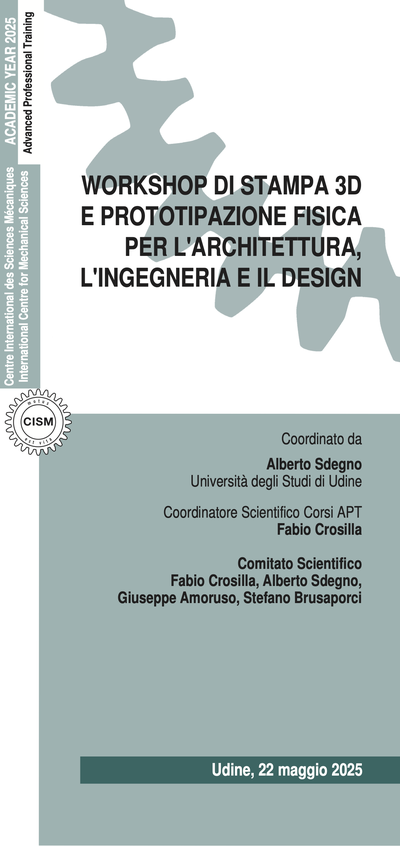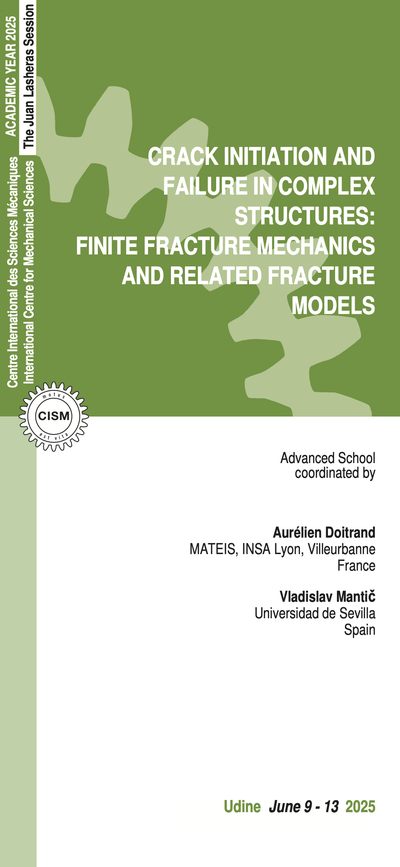The course will address the scientific topics that contribute to the mechanical and computational challenges to handle contact mechanics in the context of multibody dynamics. The reviewing of the classic theories in elastic and plastic contact, the computational algorithms for their efficient use in the framework of multibody dynamics applications, the tribology aspects characteristic of many of the mechanical systems of interest, the consequences of wear both in the response of the system and in the use of the background contact theories are just some of the aspects of relevance that justify a closer look. The application of the theories, methods and algorithms, and their inherent numerical issues, to road and railway vehicle dynamics, general mechanical systems, biomechanical and biomedical systems are just few of the areas in which the overview of the computational methods associated to contact mechanics are of major importance.
This course provides a comprehensive state-of-the-art overview of the fundamental aspects related to contact-impact events in multibody dynamics, for both rigid and flexible elements. The well-established formulations to deal with contact problems in dynamical systems and the ongoing research domains are presented and discussed with different cases of application. The course is organized around several complementary and interconnected lectures, delivered by well-known experts in each of the scientific areas addressed. A complete framework of the contact mechanics topics are provided, including constitutive laws, numerical issues, time integration, rolling contact, contact with flexible elements and with rigid elements, complementary contact formulations, penalty based contact formulations, finite element contact, application in vehicle dynamics, biomechanics, general mechanical systems, etc.
This framework requires a computationally efficient implementation of the contact detection with regards to the contacting surfaces using different search algorithms for various sizes of contact problems. The interaction between the system components is addressed alternatively via both non-smooth mechanics formulations, penalty formulations or augmented Lagrangian approaches. The particular issues associated with the contact detection between finite element meshes, used to model flexible multibody components, is also the focus of more specialized methodologies.
The characterization of the normal and friction forces is also focused in the description of the contact interaction. The temporal integration of the multibody systems in the presence of contact-impact becomes of particular relevance not only for the stability of the dynamic analysis process but also for its computational efficiency. The contact involving flexible multibody dynamics, in which the finite element method is used to describe the system components, or rigid bodies or a mixture of both, lead to more specialized methods when dealing with the interaction forces developed in the contact. Such issues are addressed and solutions proposed. In the process, not only constitutive laws for particular types of contact, such as rolling contact in the wheel-rail interface or for tire-road, are briefly addressed but also issues such a normal and friction force contact models are presented.
The course is designed to give an integrated theoretical, numerical and application perspective on most recent advances in contact dynamics, as well as potential future research directions in this scientific domain. With this purpose in mind, this course brings together lecturers with different background and schools of thought and for the purpose of presentation, discussion, refinement of a comprehensive work on different methodologies. The foreseen participants constitute a diverse, but consistent, group of researchers, specialists, advanced students, young faculty or post-doctoral researchers, dealing with the methodological and application aspects of contact mechanics and computational multibody dynamics. During the second day, a workshop will be organized when the participants introduce themselves and their current interests in terms of research.
Flores, P., (2022) Contact mechanics for dynamical systems: a comprehensive review. Multibody System Dynamics, 54, 127-177.
Dittmann, M., Franke, M., Temizer, T., Hesch, C., (2014) Isogeometric analysis and thermomechanical mortar contact problems. Computer Methods in Applied Mechanics and Engineering, 274, 192-212.
Tasora, A., Anitescu, M., Negrini, S., Negrut, D., (2013) A compliant visco-plastic particle contact model based on differential variational inequalities. International Journal of Non-Linear Mechanics, 53, 2-12.
Ambrósio, J., (2019) Selected challenges in realistic multibody modeling of machines and vehicles. IUTAM Symposium on Intelligent Multibody Systems - Dynamics, Control, Simulation, 33, 1-39.
Brogliato, B., (2023) Modeling, analysis and control of robot-object nonsmooth underactuated Lagrangian systems: A tutorial overview and perspectives, Annual Reviews in Control, vol.55, pp.297-337, 2023.
Febrer-Nafría, M., Pallarès-López, R., Fregly, B.J., Font-Llagunes, J.M., (2020) Comparison of different optimal control formulations for generating dynamically consistent crutch walking simulations using a torque-driven model. Mechanism and Machine Theory, 154, 104031.
6 lectures on: Contact analysis in multibody systems. Rolling contact mechanics and flexible multibody contact mechanics using a mixed of penalty and unilateral constraint formulations for both rigid and flexible bodies. Numerical aspects in contact-impact problems in terms of computational accuracy and efficiency. Collison detection algorithms and resolution formulations within the framework of multibody dynamics. Applications of contact-impact problems with focus on railway systems, crashworthiness problems, general machines and mechanisms of common use.
6 lectures on: Multiple impact modeling, well-posedness of the contact problem, Painleve paradoxes, feedback control of systems with joint clearances, control of robot-object dynamical systems, Lagrange-Dirichlet theorem and stability of nonsmooth Lagrangian systems.
5 lectures on: Contact mechanics theory, analytical methods for modeling and studying contact-impact events with friction in dynamical systems. Numerical methodologies to handle contact-impact events under the framework multibody dynamics formulations. Regularized methods and non-smooth formulations to treat contact-impact problems. Tribology dry and lubricated contacts for multibody dynamics. Demonstrative examples of applications will allow to highlight the key aspects related to the process of modeling contact-impact events in dynamical systems.
6 lectures on: Contact modelling approaches in biomechanical systems. Constraint forces, constitutive (compliant) force models. Percussive dynamics, center of percussion and energy theorem in percussive dynamics. Newton’s hypothesis and alternative methodologies. Contact-impact in biomechanical applications and medical devices (orthosis). Academic and clinical applications of contact-impact events.
6 lectures on: Flexible multibody dynamics, finite element contact problems, mortar methods, isometric analysis, thermomechanical problems in contacts, frictional contact formulation, large deformation in contact problems, contact in flexible and deformable bodies, energy-momentum conserving schemes in frictionless dynamic contact problems, finite-deformation phase-field approach to fracture, demonstrative and practical examples.
6 lectures on: Non-smooth formulations for frictional contact problems in multibody dynamics. Numerical methods for large-scale complementarity problems. Methods for efficient collision detection: broad-phase and narrow-phase algorithms, implementation details and computational aspects. Explicit smooth/nonsmooth co-simulation using kinematic constraints. Examples, benchmarks and applications to engineering problems.





